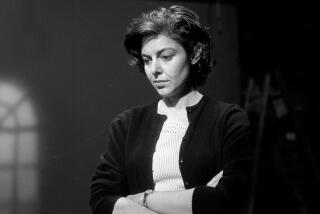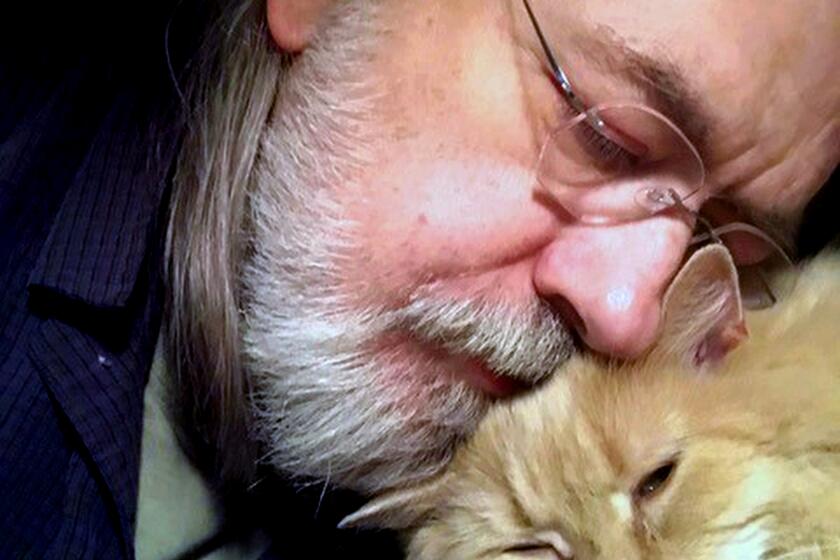Book Publishers See ’87 as a Killer Year for True-Crime Tales
Greed, sex, illegitimacy, drugs, betrayal, murder and money are the elements the publishers talk about in their capsule descriptions of “The Serpent’s Tooth,” “Blood Relations,” “Money to Burn” and “For Love of Money.” All four, out this spring and fall, concern the 1985 murder of tobacco heiress Margaret Benson and her adopted son Scott by 35-year-old Steven Benson, Margaret Benson’s older son.
The Benson case is but one of the story lines that appear in an explosion of true-crime books on the spring lists of major publishers. The kind of books that send Hollywood slavering promise to continue their incursion into the bookstores at least into the fall.
Two books, “Echoes in the Darkness” and “Engaged to Murder,” are out this season on the so-called Main Line murders in suburban Philadelphia eight years ago. Terms used to describe them are more global, scrutinizing the ability of society to live with guilt and innocence in even the briefest summaries.
Robert Mayer’s “The Dreams of Ada,” published this month on the 1984 disappearance and presumed murder of a recently married convenience store clerk in rural Oklahoma, gets a similar synopsis, emphasizing the author’s examination of the values of small-town America. Yet another recent title, John Bryson’s “Evil Angels” (Summit), stirs Satanism and wild dogs into the much-publicized 1980 murder in Australia of a 9-week-old girl called Azaria as it explores “evil in the Outback.”
Good samaritanship is a key issue in Richard Hammer’s “The CBS Murders” (due out next month from William Morrow & Co.), about the 1982 murders here of a bookkeeper involved in a multimillion-dollar diamond swindle and the two technicians who attempted to come to her rescue. And to “Small Sacrifices,” a May-publication-date, 487-page psychological profile of an Oregon surrogate mother convicted of shooting her three children, one fatally, in 1983, are added the ingredients of incest, child abuse, jilted lovers and shopping malls. “The stuff,” in the view of publisher New American Library, “of which soap operas are made.”
Certainly, as fans of Truman Capote’s “In Cold Blood,” Tommy Thompson’s “Blood and Money” or, more recently, “Fatal Vision” by Joe McGinnis, will attest, the genre is hardly new. “There are murders in the Bible, let’s go back to that,” said Jeanne Bernkopf, a special editor for William Morrow & Co. who has worked with Joseph Wambaugh on seven true-crime books, most recently the already best-selling “Echoes in the Darkness.”
“It’s always been a good area of publishing,” agreed Larry Ashmead, executive editor at Harper & Row, publisher of one of the Benson books, Christopher Andersen’s “The Serpent’s Tooth.” “When you have a success in this area--and there have been watershed successes--it’s an editor’s dream. It’s a nonfiction subject, it’s melodramatic and there’s vast appeal to the public. They’re exciting books to write for the writers, to edit for the editors, for the publishers to publish and for the salesmen to sell.
“They have great stakes,” Ashmead said. “When these books hit, they hit very big.”
In the case of “In Cold Blood,” for example, often considered the granddaddy of the contemporary true crime story, those big stakes have meant nearly 5-million hardback and paperback books in print since the book was first published in 1966. “Fatal Vision,” in which Joe McGinnis probed the murder of Dr. Jeffrey MacDonald’s wife and children, has racked up more than 3 million copies in hardback, paperback and book club editions since it first appeared in 1983.
No Guarantee
On the other hand, Ashmead said, a juicy crime is no automatic guarantee of mammoth publishing sales figures. “You look at anybody’s list,” he said, “and there are more gravestones in this category than anything else--books they had great expectations for, and they just didn’t take off.”
Still, said Dan Frank, the senior editor at Viking who edited Robert Mayer’s “The Dreams of Ada,” about a still-bodyless murder in Oklahoma, “Publishing can be very imitative. Publishers see one kind of book working, and they jump in, thinking there’s a whole spate of books to be pursued. Look at all the business-executive-type books ‘Iacocca’ produced.
“All these things go in waves,” Frank said. “If true crime books weren’t selling, publishers would drop them.”
If no other proof were necessary, what Ashmead calls the “mind-boggling” appearance in a single season of four books on the Benson murders in Florida would confirm that far from dropping this genre, publishers in fact are embracing true-crime topics with renewed passion.
Led by John Greenya’s “Blood Relations” (written in cooperation with Carol Lynn Benson Kendall, the only survivor of the murder plot) for Harcourt Brace Jovanovich and out this month, the crop of Benson books will be followed June 3 by Andersen’s “The Serpent’s Tooth” for Harper & Row, with Michael Mewshaw’s “Money to Burn” (Atheneum) appearing later the same month. In September, Pocket Books will publish the sole paperback in the bunch, “For Love of Money” by Mary Walton.
Four-Way Phenomenon
No one knows just how or why this particular crime generated what “Blood Relations” editor Marie Arana-Ward calls the “quite unusual” phenomenon of four essentially concurrent books on a single, highly publicized case of murder, nor will anyone involved predict if the four books will kill each other in the marketplace, or if the apparent public fascination with family foul play will sustain them all.
After all, even “For Love of Money” author Walton describes the Benson case as “a good murder, but not a great murder.” Watching the gaggle of journalists and authors converging on the courtroom in Ft. Meyers, Fla., for the Benson trial, Walton became convinced that it was the subject of crime, not the particular crime that was generating all the interest.
“It’s not that everyone was vying for this one,” said Walton, a writer for the Philadelphia Inquirer Sunday magazine. “Everyone is vying for everything.”
For former Time and People magazine writer Christopher Andersen, the attraction of the case in which Margaret and Scott Benson were blown apart in the family station wagon was simply that “it had all the elements: Money, murder, money, family, money . . . money . . . money.”
Wealth and Wildness
The money came from tobacco, the Lancaster Leaf empire, founded by Margaret Benson’s father Harry Hitchcock. The family turned out to have more than its share of both eccentrics and eccentricities: Steven Benson, for example, the electronics nut who made a habit of failing at grandiose business schemes; Scott Benson, the would-be tennis star, prone to violence, not to mention laughing gas and cocaine; Carol Lynn Benson Kendall, sole survivor of the car bomb, who revealed in the course of the murder investigation that her “adopted brother” Scott was in fact her illegitimate son.
In short the Benson clan seemed intent on validating the American cultural conviction that the rich not only have more money than everyone else, but also are somewhat more complicated.
“Classically, it seems, the books of this sort that are the most interesting combine a lot of money with some sort of very complicated, and in some cases even gothic family entanglements,” said Tom Stewart, president and publisher of Atheneum. More succinctly, Stewart added, “I wouldn’t underplay the crazy family part in these stories as a category.”
“I think people are at once fascinated by the family relationships and horrified by the excess,” Christopher Andersen concurred. “We are in a society that is obsessed by financial success to an extent that is ludicrous. When money is involved in almost any of these stories--then when you have violence on top of that, there is definitely the crucial element.”
In the case of the Benson murder, said Andersen, an ex-New Yorker now living in Woodbury, Conn., “It’s where a fellow tried to rub out his entire family, for money.”
As Atheneum’s Stewart pointed out, the money connection is as old and as established in the mind of the reading public as is true crime itself. “Not to compare any of these writers to Shakespeare,” Stewart said, “but he didn’t write often about peasants.”
Whether in true crime stories or in the still-burgeoning area of romance novels, the travails of the wealthy continue to lure readers onto the printed page. “I think those of us who are Middle America in income, and less, may want to read about rich people who failed, who did terrible things,” said Ann Rule, the Seattle-based author, most recently of “Small Sacrifices” (due out this month from New American Library), about an Oregon mother (albeit not a wealthy woman herself) who shot her three children. “People want to be able to say, ‘Look at them, they have all that money, but are they happy? And are they nice?’ ”
“People like to believe that rich people are miserable,” said “Small Sacrifices” editor Michaela Hamilton, an executive editor at New American Library. “They don’t read books about happy rich people. You like to think that rich people have the same problems we do, only magnified because of their money.”
With its implicit notion of indulgence, the money helps make a story like the Bensons’ a “cautionary tale,” in the view of Washington, D.C.-based author John Greenya. “It’s ‘there but for the grace of God. . . , ‘ “ Greenya said. “I think that’s the continuing interest in these stories.”
Getting to the Point
While intrigued by the “most unusual” situation in which a son would be moved to kill his mother, Greenya said that what drew him to this story were the questions of “How does a family get to this point? What kind of a family was it that permitted this horrible thing happened? Do the traditional values relate in a case like this? What are the institutions of society that normally keep things like this from happening?”
In the field of true-crime writing, many of those involved contend, such puzzlements take on a kind of universal dimension. “When you walk into that kind of ugliness, your own life looks much more forgivable and in many ways more pleasant,” said Nan Graham, a senior editor at Viking who worked on Loretta Schwartz-Nobel’s “Engaged to Murder.” “It’s an opportunity for you basically to grease the wheels of your own judgment.”
Besides, Graham said, “Everybody is fascinated by that dark side. I don’t know why people want to read about violence, why people want to see it, where there is this lurid fascination. But it sure isn’t new. Those public executions weren’t an accident.”
More to Read
More to Read
Sign up for our Book Club newsletter
Get the latest news, events and more from the Los Angeles Times Book Club, and help us get L.A. reading and talking.
You may occasionally receive promotional content from the Los Angeles Times.






